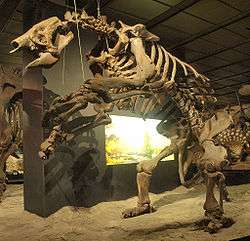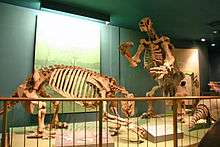Eremotherium
| Eremotherium | |
|---|---|
 | |
| E. laurillardi at the HMNS | |
| Scientific classification | |
| Kingdom: | Animalia |
| Phylum: | Chordata |
| Class: | Mammalia |
| Superorder: | Xenarthra |
| Order: | Pilosa |
| Family: | †Megatheriidae |
| Subfamily: | †Megatherinae |
| Tribe: | †Megatheriini |
| Subtribe: | †Megatheriina |
| Genus: | †Eremotherium Spillmann, 1948 |
| Species | |
| |
Eremotherium is an extinct genus of ground sloth of the family Megatheriidae, endemic to North America and South America during the Pleistocene epoch. It lived from 4.9 mya—11,000 years ago existing (as a genus) for approximately 4.889 million years.[1]
E. rusconi reached a length up to 6 m (20 ft) and a weight of more than 3 tonnes.[2]
Taxonomy
Eremotherium was named by Spillmann (1948) and was assigned to Megatheriinae by Gaudin (1995); and to Megatheriidae by Spillmann (1948), Carroll (1988) and Cisneros (2005).
Fossil distribution
Fossils have been uncovered from Volusia County, Florida, Chatham County, Georgia; Berkeley County, South Carolina; Espirito Santo; and Pedra Preta, Brazil; Tarapoto, Peru (giant form); Rio Canas, Ecuador.[3]
Species
E. eomigrans
E. eomigrans was named by De Iulis and Cartelle (1999). E. eomigrans was assumed to have been restricted to Florida, as most fossil specimens have been recovered from that area. However, in 1993, another specimen was recovered in North Carolina.[4] It lived from 4.9 mya—300,000 years ago (4.6 million years).
- De Soto Shell Pit, DeSoto County, Florida. est. age ~1.6 Mya.
- Payne Creek Mine, Polk County, Florida. est. age 1.6—1.5 Mya.
- Crystal River Power Plant, Citrus County, Florida. est. age 1.6—1.5 Mya.
- Inglis IA Site, Citrus County, Florida. est. age ~1.5 Mya.
- Haile 7C Site, Alachua County, Florida. est. age ~1.6—1.5 Mya.
- Haile 16A Site, Alachua County, Florida. ~1.6—1.5 Mya.
- Cross Florida Barge Canal, Levy County, Florida. est. age ~1.6 Mya—400,000 years ago.
- McLeod Limerock Mine, Levy County, Florida. est. age ~400,000 years ago.
- Randall Parkway, New Hanover County, North Carolina. est. age ~400,000 years ago.
E. laurillardi

E. laurillardi, sometimes called the Panamerican ground sloth, was named by Lund (1842). It was previously considered a nomen dubium by Hoffstetter (1952), Gazin (1957) and Paula Couto (1979); it was recombined as Eremotherium laurillardi by Hoffstetter (1954), Cartelle and Bohorquez (1982), Cartelle and De Iuliis (1995) and Hulbert and Pratt (1998).[5][6] Fossil distribution was from the southern U.S. to Brazil. It lived from 780,000—11,000 years ago (0.769 million years).
Fossil distribution
- Fossilossa Site, Chatham County, Georgia. est. age ~2.0 Mya—400,000 years ago.
- Isle of Hope, Chatham County, Georgia. est. age ~2.0 Mya.
- Edisto Island, South Carolina est. age 400,000 years ago.
- El Bosque, Nicaragua. est. age ~2.3—400,000 years ago.[7]
- Masachapa, Nicaragua. est. age ~23.03 Mya.
- La Coca, Panama. est. age ~500,000—400,000 years ago.
- Zumbador Cave aka Cueva del Zumbador, Falcon, Venezuela. est. age ~1.8 Mya—11,000 years ago.
- Cucuruchu, Venezuela. est. age ~125,000—11,000 years ago.
- Rio Canas Site, Manabi, Ecuador. est. age ~781,000—11,000 years ago.
- Lagoa do Ipu Site, Ceara; Lage Grande-Level 1 & 2 Pernambuco, (Brazil. est. age ~1.8 Mya—11,000 years ago.
- Toca da Janela da Barra do Antoniao and Lagoa Sao Vitor Piaui, Brazil. est. age ~126,000—11,000 years ago.
- Toca da Esperanca, Bahia, Brazil. est. age ~126,000—11,000 years ago. est. age ~291,000 +/-84,000—204,000 years ago +/- 34,000.[8]
References
- ↑ PaleoBiology Database: Eremotherium, basic info
- ↑ Kürten, Björn (1980) Pleistocene mammals of North America p.140
- ↑ Paleobiology Database: Panthera onca mesembrina, collections.
- ↑ Fields, Steven E., et al. "THE GROUND SLOTHS (PILOSA) OF SOUTH CAROLINA." PalArch's Journal of Vertebrate Palaeontology 9.3 (2012).
- ↑ C. Cartelle and G. De Iuliis. 1995. Eremotherium laurillardi: the Panamerican late Pleistocene megatheriid sloth. Journal of Vertebrate Paleontology
- ↑ C. L. Gazin. 1957. Smithsonian Miscellaneous Collections 134
- ↑ W. D. Page. 1978. The geology of the El Bosque archaeological site, Nicaragua. Early Man in America from a Circum-pacific Perspective 231-260
- ↑ H. Lumley, M.-A. Lumley, M. C. Moraes Coutinho Beltrao, Y. Yokoyama, J. Labeyrie, J. Danon, G. Delibrias, C. Falgueres, and J. L. Bischoff. 1987. L'Anthropologie 91:917-942
- Dinosaur Encyclopedia by Jayne Parsons
- After the Dinosaurs: The Age of Mammals (Life of the Past) by Donald R. Prothero